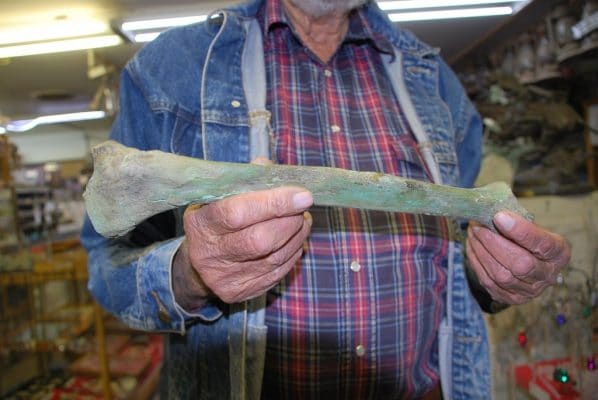
Human remains are rock shop owner’s claim to fame
Lin Ottinger is famous in the small town of Moab.
Since 1960, he has owned and operated Lin Ottinger’s Rock Shop. The Moab Rock Shop is a combination store and museum can at once be seen as an authentic dedication to a love of geology and paleontology, and a tourists love it.
Lin has an odd sense of humor, with some of his statements, perhaps intended to be humorous, falling flat and nearly indiscernible to a young reporter.
Ottinger’s Rock Shop website quotes an article from 20 years ago that calls him a “rock hound,” but the Ottinger of 2019 brushes off his old age, claiming that he is not a rock hound, but “just a pebble pup.”
Aside from having been one of the pioneering guides in the canyon country around Moab in the 60s, and discovering a number of dinosaur bones, Ottinger has a 1971 find of human remains among his claims to local fame. The two human skeletons found by Ottinger at age 43—along with a then 11-year-old son—became fuel for creationists espousing beliefs of humans living alongside dinosaurs.
Moab Man (or Malachite Man)
The find became known as “Moab Man,” or “Malachite Man,” in reference to a green mineral that presumably lent its color to the bones.
The find is of interest to creationists because these skeletons were found in a level of rock that appears to indicate that humans were alive over 100 million years ago. The Old Earth creationists’ belief in this theory claimed that the skeletons were part of the Dakota Formation, a geologic formation approximately 94–113 million years old.
 Native Americans, naked Mormons, or friends of dinosaurs?
Native Americans, naked Mormons, or friends of dinosaurs?
Were the humans living alongside dinosaurs? John Marwitt, the archaeologist who initially investigated the find along with Ottinger, says no, that did not happen, and the Malachite Man discovery is not evidence of such. They say the sand immediately surrounding the skeletons was loose dirt rather than the compacted sandstone the geologic era is now known for. Hence, the human remains got there at a much later time. Beyond that, Ottinger and the scientists disagree on some specifics.
Marwitt concluded that the remains were most likely of Native Americans, intentionally buried, while Ottinger concluded that they were of Mormons, unintentionally buried. Carbon dating done by a UCLA lab indicated that the bones were deposited anywhere from around 1700 to 1840 CE. Ottinger says that nearby uranium deposits interfered with the accuracy of the radiocarbon dating. “That carbon became radioactive. So when they tested it, it was like a new carbon out of the air, not even deteriorated. Only maybe 100, 50, or 30 years.”
If his hypothesis of radioactive uranium interfering with the test results is true, then it would logically follow that the skeletons were actually older than what the lab reported, not more recent.
Ottinger says he found the skeletons near a large Native American hearth. “The hearth was there,” he claims, “and prehistoric people lived there, thousands of years ago. The hearth was at two different elevations close to each other.”
Ottinger claims that the separated hearth artifacts indicated that an earthquake happened. “He probably was a Mormon, because all Mormons, when they went into mines, always carried a nude woman on their backs. They were both laying face down. An earthquake happened and shook them. He stood in front of her to protect her. A rock hit him and killed him. And then a rock fell on top of her and killed her. And so she fell down on top of him.”
Ottinger stated more reasoning for why he thought the remains were not of Native Americans. “There wasn’t one chip of agate or rock, or tools made by humans. I screened the rock, collecting azurite. These were prehistoric tool people,” he insists.
“These people make it all up, that it was 2 million years ago, that it was 100 million years ago. But I know the truth — I spent time out there studying it.” — Lin Ottinger
Utah is home to all sorts of incredibly fascinating characters. Check them out … which ones are your favorites?





